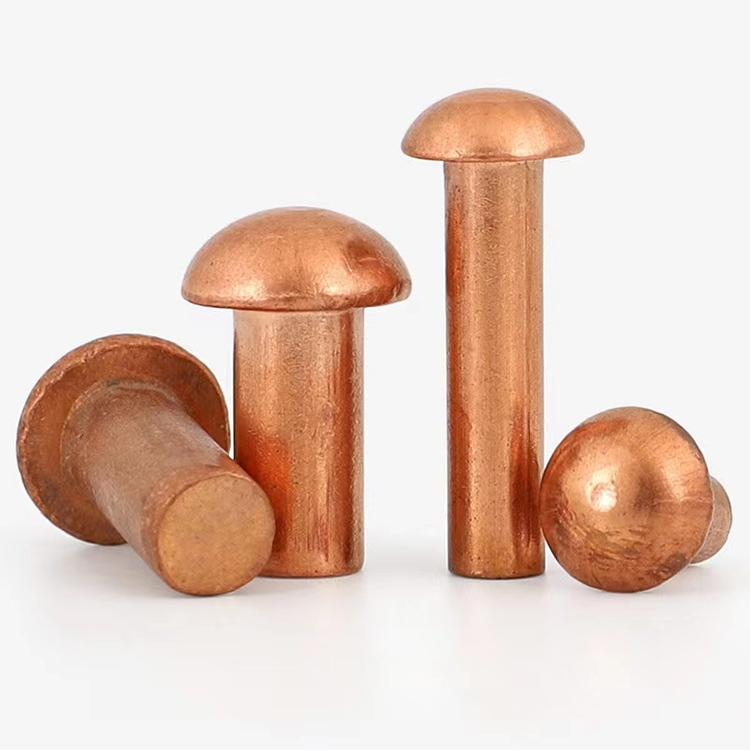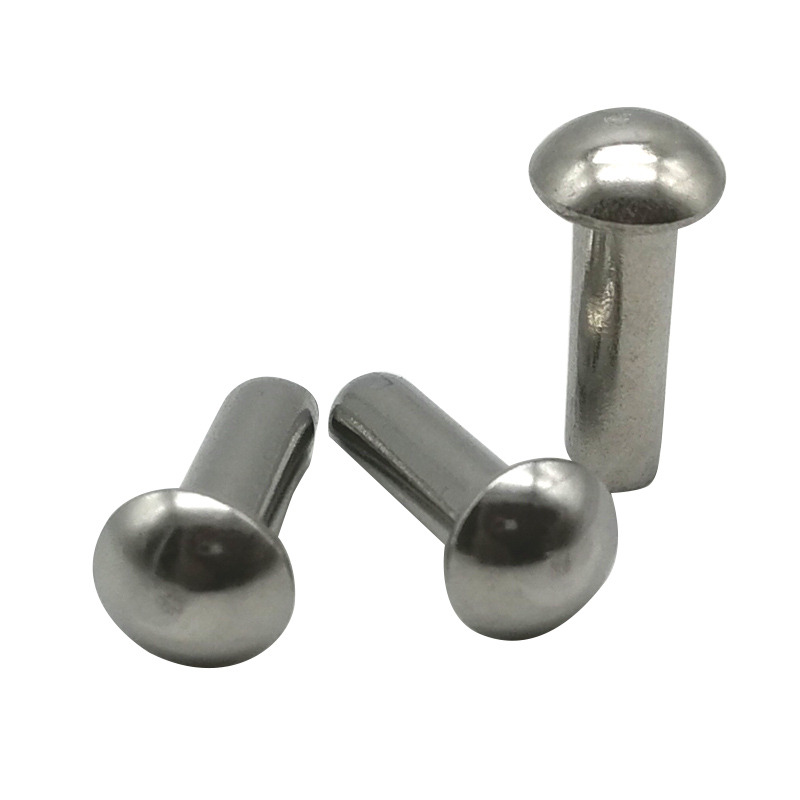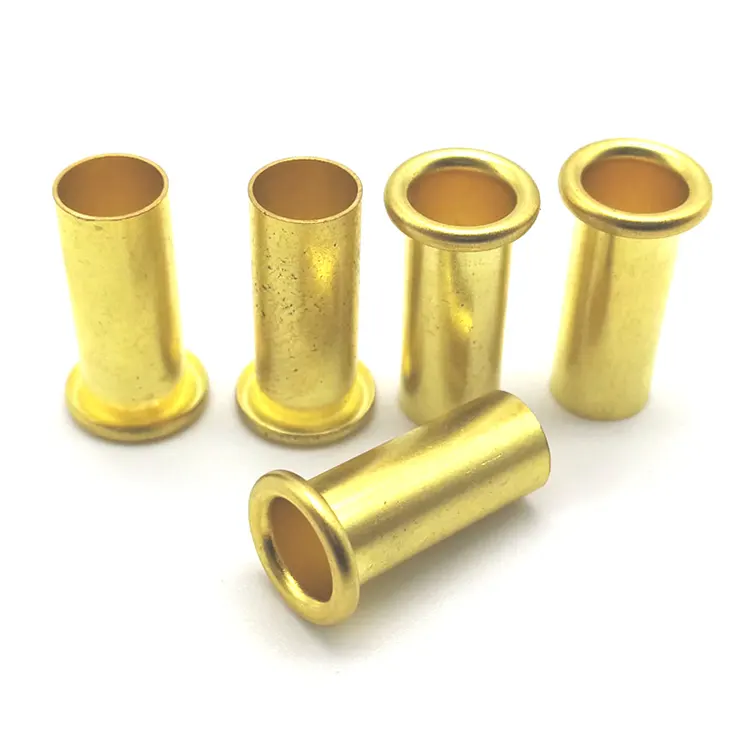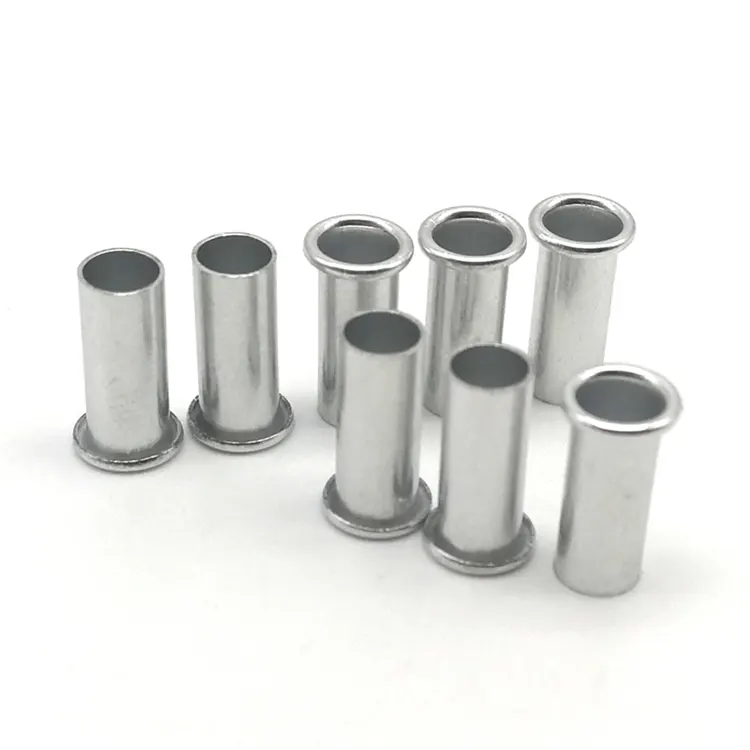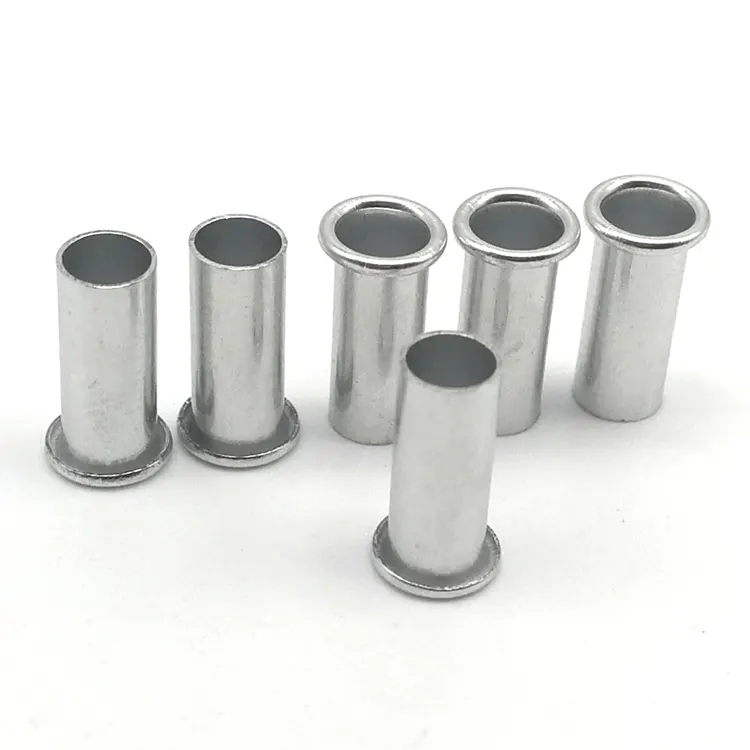Đinh tán hình ống đầy đủ
As one of professional high quality Full Tubular Rivets manufacturer, you can rest assured to buy Full Tubular Rivets from Notin and we will offer you the best after-sale service and timely delivery.
Full tubular rivets are also called as hollow rivets or tubular rivets, they are a common mechanical fastener, primarily used in applications requiring lightweighting or ventilation. Their structural characteristics are a completely hollow center with heads at each end, achieving connection through plastic deformation. Widely used in electronics, automotive manufacturing, aerospace, and other fields, they are favored for their unique structural design.
What is a hollow rivet?
A full tubular rivet consists of a shank and a head. The shank has a through hole in the center, and the head is typically round or oval. During installation, the rivet is inserted through the materials to be joined, and the tail is expanded using a specialized tool to form another head, securing the materials together. Because of the hollow center, full tubular rivets maintain ventilation or fluid conduction after connection, which is their primary difference from solid rivets.
What materials can full tubular rivets be made of? What are the characteristics of different materials?
full tubular rivets are made from a variety of materials, with aluminum alloy, stainless steel, and copper being common.
Aluminum tubular rivets are lightweight and corrosion-resistant, making them suitable for electronic products and lightweight structures. They are the most cost-effective rivets.
Stainless steel tubular rivets are strong and heat-resistant, and are often used in automobiles and industrial equipment. They are more expensive than aluminum hollow rivets.
Brass tubular rivets or copper tubular rivets have good conductivity and are mostly used for electrical connections. Their disadvantage is that they are relatively expensive.
When selecting materials, factors such as the use environment, stress conditions, and cost should be considered.

Installation method of full tubular rivets
Special tools are required to install hollow rivets, such as manual riveting machines or fully automatic assembly machines.
The operation steps are as follows:
(1) Drill a hole in the material to be connected, with the hole diameter slightly larger than the rivet diameter.
(2) Insert the rivet into the hole, ensuring that the head is close to the surface of the material.
(3) Align the rivet hole with the matching punch (the punch is installed on the riveting machine). (4) Shake the riveting machine so that the tail of the rivet is impacted by external force and curls up, forming the same arc as the head, thereby achieving the fastening function.
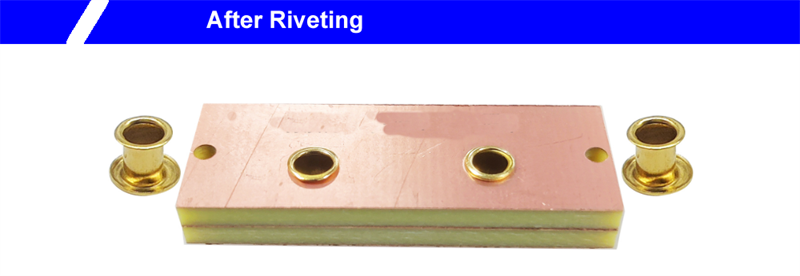
Advantages of Full Tubular Rivets
(1) Light weight: The hollow structure reduces the amount of material used and is suitable for weight-sensitive applications.
(2) Good air permeability: The through hole in the middle can be used for ventilation or diversion to avoid sealing problems.
(3) Easy installation: Only one-side operation is required, which is suitable for narrow spaces or occasions where the back cannot be accessed.
(4) Low cost: Compared with welding or bolting, the riveting process is simple, saving time and manpower.
Disadvantages of Full Tubular Rivets
(1) Limited strength: The hollow structure leads to weak tensile and shear resistance, which is not suitable for high-load scenarios.
(2) Non-removable: Once installed, the rivet is usually not reusable, and disassembly will damage the connection.
(3) Requirements for material thickness: Materials that are too thin or too thick may affect the riveting effect.
What are the main applications of hollow rivets?
(1) Electronic products: such as computer cases, radiators, etc., taking advantage of their lightweight and air permeability.
(2) Automotive manufacturing: used for non-load-bearing parts such as interior panels and wiring harness fixings.
(3) Aerospace: reduce weight while meeting some ventilation needs.
(4) Furniture assembly: connect metal or plastic parts and simplify the installation process.
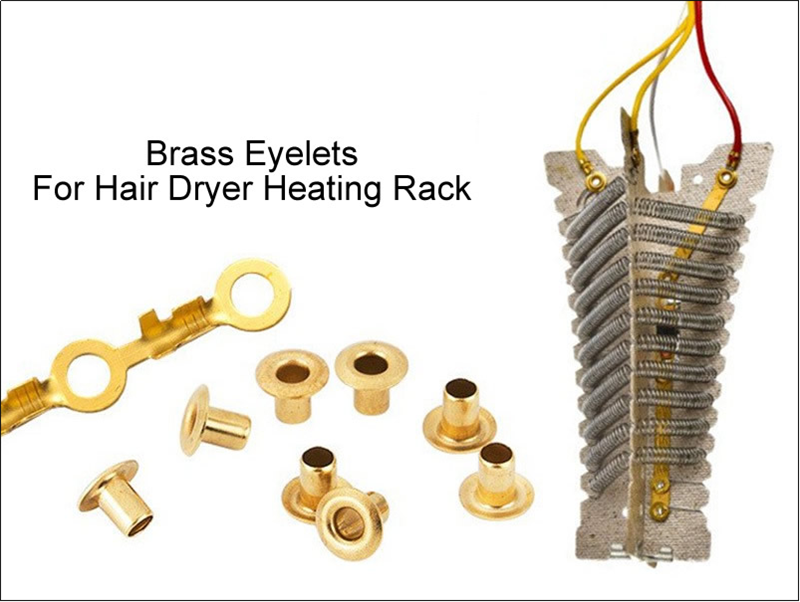
Comparison between hollow rivets and other rivets
(1) Compared with solid rivets: full tubular rivets are lighter and breathable, but have lower strength.
(2) Compared with semi-tubular rivets: the tail of semi-tubular rivets is partially hollow, with slightly higher strength, but the ventilation is not as good as full hollow rivets.
(3) Compared with blind rivets: the mandrel of blind rivets remains after installation, while the mandrel of full hollow rivets is completely detached, making the connection neater.
Suggestions for purchasing full tubular rivets
(1) Select rivets of appropriate length according to the thickness of the material to ensure that they can fully expand after installation.
(2) Consider the use environment. For example, corrosion-resistant or high-temperature resistant materials should be selected for humid or high-temperature conditions.
(3) Before purchasing in bulk, you can try it out first to confirm the riveting effect and tool compatibility.
Maintenance and precautions for full tubular rivets
(1) Avoid excessive force during installation to prevent rivet deformation or material damage.
(2) Regularly check the connection parts and replace them in time if they are loose or rusted.
(3) Keep them away from moisture during storage to prevent oxidation of the rivet surface that affects their use.
As a practical connector, full tubular rivets have irreplaceable advantages in specific scenarios. Understanding their characteristics and application methods will help you choose and use them reasonably in actual work, improving work efficiency and connection quality.
- View as
Đinh tán ống bằng đồng
đinh tán ống bằng đồng là đinh tán rỗng làm bằng đồng thau, điển hình là hình trụ có hình dạng trung tâm. Chức năng chính của chúng là kết nối hai hoặc nhiều thành phần thông qua tán xạ. Chúng thường được sử dụng trong các ứng dụng đòi hỏi độ dẫn nhẹ, độ dẫn điện hoặc khả năng chống ăn mòn. Đồng thau là một hợp kim bằng đồng, nó có tính chất cơ học tuyệt vời và khả năng chống ăn mòn, làm cho nó phù hợp với các ốc vít này. Nuote Metal là một nhà sản xuất proffesional của đinh tán ống bằng đồng.
Đọc thêmGửi yêu cầuĐồng thau rỗng đinh tán
Các đinh tán rỗng bằng đồng thường được làm bằng ống đồng. Các ống đồng là khó, không dễ bị ăn mòn, và chống lại nhiệt độ cao và áp suất cao. Chúng có thể được sử dụng trong một loạt các môi trường. Đồng thời, chúng dễ uốn cong, xoắn, nứt và phá vỡ hơn kim loại thông thường. Nuote Metal là một nhà sản xuất chuyên nghiệp của đồng thau rỗng ở Trung Quốc, chúng tôi ở trong ngành này trong hơn 10 năm.
Đọc thêmGửi yêu cầuĐinh tán ống nhôm
Các đinh tán ống nhôm được làm từ hợp kim nhôm có độ bền cao, tự hào với các đặc tính nhẹ đáng chú ý, với mật độ chỉ một phần ba so với đinh tán thép. Hơn nữa, vật liệu này cung cấp khả năng chống ăn mòn tuyệt vời, chống lại sự xói mòn một cách hiệu quả từ môi trường khí quyển và nước biển. Thiết kế cấu trúc rỗng độc đáo giúp giảm thêm trọng lượng trong khi duy trì sức mạnh. Các đinh tán ống Aaluminum được tạo ra bởi các kim loại Nuote có độ chính xác cao, vui lòng gửi cho chúng tôi yêu cầu của bạn.
Đọc thêmGửi yêu cầuĐinh tán ống nhôm
Nuote Metals là nhà sản xuất Đinh tán ống nhôm tại Trung Quốc. Đinh tán ống nhôm chủ yếu bao gồm đầu đinh tán và thân. Thân là một hình trụ rỗng thường được làm từ hợp kim nhôm như 5052 hoặc 6061, có độ dẻo và khả năng chống ăn mòn tuyệt vời. Hợp kim nhôm này góp phần tạo nên độ nhẹ tổng thể của đinh tán, khiến nó phù hợp với các ứng dụng nhạy cảm với trọng lượng. Hơn nữa, lớp oxit tự nhiên của nhôm ngăn chặn hiệu quả rỉ sét từ các yếu tố môi trường, kéo dài tuổi thọ sử dụng.
Đọc thêmGửi yêu cầuĐinh tán nhôm rỗng
Đinh tán nhôm Holllow là loại dây buộc thông dụng, được sử dụng rộng rãi trong nhiều lĩnh vực do trọng lượng nhẹ, khả năng chống ăn mòn và dẫn điện tốt. Nuote Metals sản xuất và bán đinh tán rỗng bằng nhôm ở Trung Quốc, chúng tôi có hơn 10 năm kinh nghiệm làm việc trong ngành này.
Đọc thêmGửi yêu cầuĐinh tán hình ống
Các đinh tán hình ống thường bao gồm một thân và một nắp, với một trung tâm rỗng. Thiết kế này cho phép phần cuối của thân cây cuộn tròn ra ngoài khi chịu áp suất dọc trục, tạo thành một cấu trúc giống như nắp khác, do đó kẹp hai hoặc nhiều vật liệu lại với nhau. Không giống như đinh tán rắn quen thuộc, đinh tán rỗng không yêu cầu búa từ phía đối diện, làm cho chúng phù hợp hơn cho các ứng dụng lắp ráp chỉ có thể được vận hành từ một bên.
Đọc thêmGửi yêu cầu
